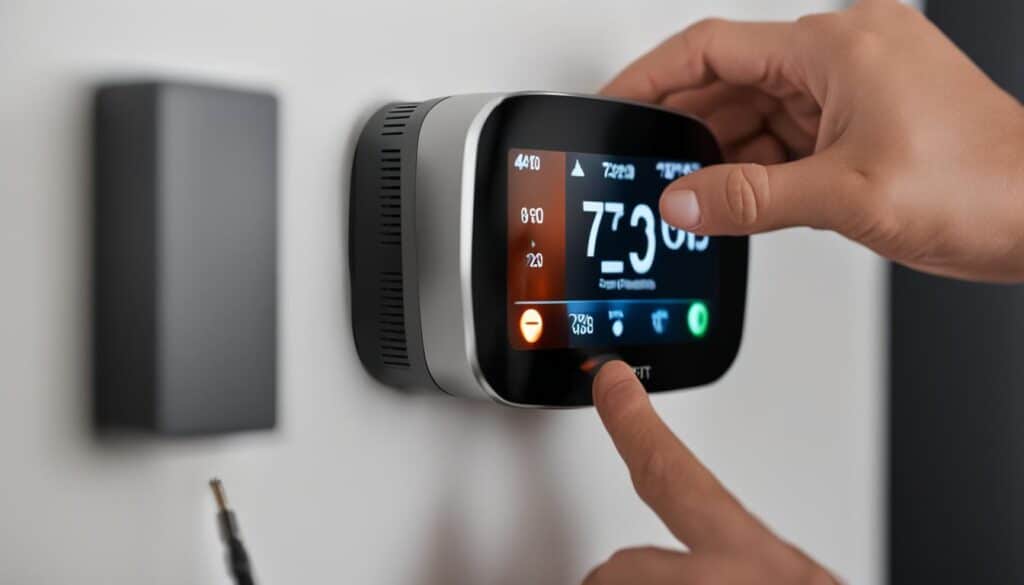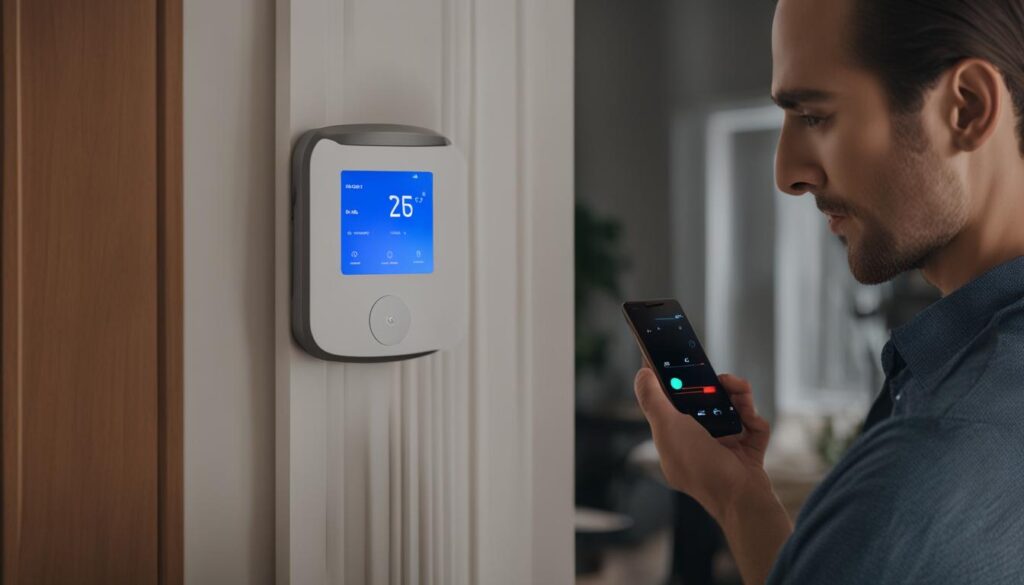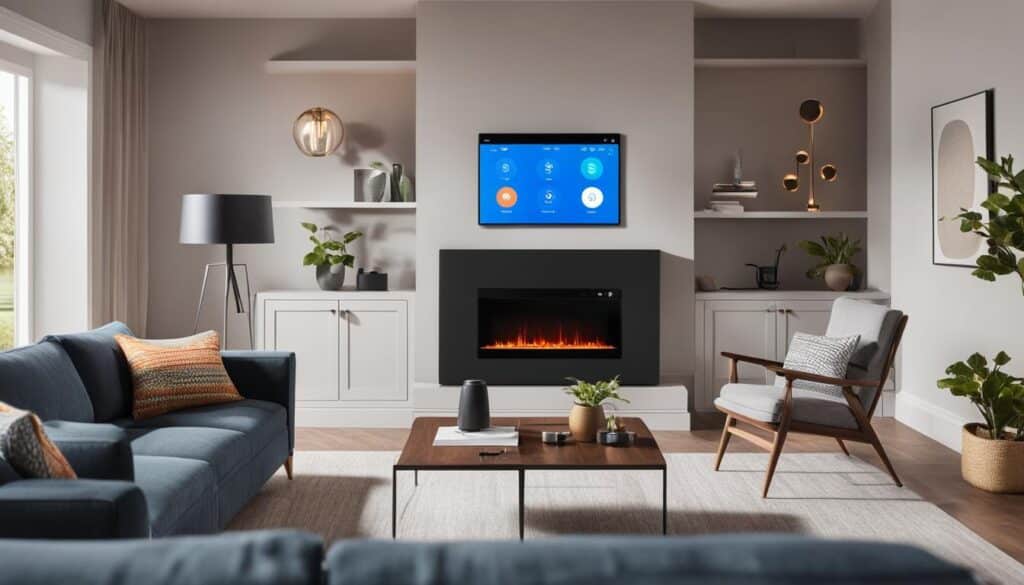Are you considering upgrading to a smart thermostat? With the increasing popularity of smart home devices, smart thermostats have become an essential component for modern homes. They not only offer convenience but also help save energy and reduce utility bills. If you’re new to the world of smart thermostats, don’t worry. In this beginner’s guide, I will provide you with all the information you need to choose the right smart thermostat for your home and guide you through the setup process.
Before we delve into the details, let’s first understand what smart thermostats are. These innovative devices allow you to control your home’s heating and cooling systems remotely using your smartphone or other connected devices. Some smart thermostats even learn your preferences and adjust the temperature accordingly, optimizing energy consumption while keeping you comfortable.
Table of Contents
Key Takeaways:
- Smart thermostats are essential for modern homes, offering convenience and energy savings.
- They allow you to control your home’s temperature remotely through your smartphone or other connected devices.
- Some smart thermostats have learning capabilities, optimizing temperature settings based on your preferences and schedule.
- Smart thermostats can help reduce energy consumption and lower utility bills.
- Choosing the right smart thermostat and following the correct setup process is crucial for optimal performance.
Types of Smart Thermostats
When it comes to choosing a smart thermostat, you have a variety of options to consider. Let’s explore the different types of smart thermostats available:
1. Programmable Thermostats
Programmable thermostats allow you to set temperature schedules based on your daily routine. You can create different settings for weekdays and weekends, ensuring optimal comfort while saving energy.
2. Learning Thermostats
Learning thermostats take smart heating and cooling to the next level. They use advanced algorithms to analyze your temperature preferences and adjust the settings automatically. Over time, they learn your habits and create personalized schedules for maximum comfort and energy efficiency.
3. Remote-Controlled Thermostats
Remote-controlled thermostats give you the ability to control your home’s temperature remotely using your smartphone or other smart devices. Whether you’re at work or on vacation, you can easily monitor and adjust the temperature to suit your needs.
Each type of smart thermostat offers unique features and benefits. Understanding these options will help you make an informed decision and choose the right thermostat for your home.
Adding an image helps to visualize the different types of smart thermostats.
Features to Consider When Buying a Smart Thermostat
When purchasing a smart thermostat, there are several important features to consider that can greatly enhance the convenience and energy efficiency of your home heating and cooling system. These features not only provide greater control over your HVAC system but also contribute to cost savings and a more comfortable living environment.
Voice Control
One of the key features to look for in a smart thermostat is voice control. With voice control capabilities, you can easily adjust the temperature in your home hands-free. Simply use voice commands and your smart thermostat will respond accordingly. This feature offers a new level of convenience and accessibility, allowing you to control your thermostat from anywhere in the room.
Energy-Saving Modes
An energy-saving mode is another crucial feature to consider when buying a smart thermostat. This feature allows the thermostat to automatically adjust the temperature based on your preferences and occupancy patterns. By optimizing your heating and cooling settings, you can reduce energy consumption and lower utility bills without compromising comfort.
Compatibility with Your HVAC System
Before purchasing a smart thermostat, it’s important to ensure compatibility with your existing HVAC system. Different smart thermostats may work with specific types of heating and cooling systems. Checking compatibility will help you avoid compatibility issues and save you from unnecessary hassle and expenses. Most smart thermostat manufacturers provide compatibility information on their websites or in the product specifications.
Customized Schedules
The ability to create customized schedules is another feature that can significantly improve the functionality of your smart thermostat. With this feature, you can program your thermostat to follow a specific temperature schedule that aligns with your daily routine. For example, you can set the thermostat to lower the temperature when you’re away from home and raise it just before you return. This flexibility allows you to maintain comfort while maximizing energy efficiency.
Did You Know? According to the U.S. Department of Energy, using a programmable thermostat can save you up to 10% on heating and cooling costs annually.
Smart Thermostat Comparison Table
| Feature | Brand A | Brand B | Brand C |
|---|---|---|---|
| Voice Control | ✓ | ✓ | ✗ |
| Energy-Saving Modes | ✓ | ✓ | ✓ |
| Compatibility with HVAC System | ✓ | ✗ | ✓ |
| Customized Schedules | ✗ | ✓ | ✗ |
In the table above, you can compare the availability of key features across different smart thermostat brands. This can help you make an informed decision based on your specific requirements and priorities.
By carefully considering these features, you can confidently select a smart thermostat that suits your needs and preferences. Remember, investing in a smart thermostat can bring long-term benefits by optimizing energy usage and improving your overall home comfort.
Installation Process for Smart Thermostats
Installing a smart thermostat is a straightforward process that can be completed by following a few simple steps. While the specifics may vary depending on the model and manufacturer, the general installation process remains consistent. Here, I will outline the key steps to install your smart thermostat successfully:
- Turn off the power: Before you begin, ensure that the power to your HVAC system is turned off. This step is essential to protect yourself and prevent any electrical mishaps during the installation.
- Remove the old thermostat: Carefully remove the existing thermostat from the wall by unscrewing it from its mounting plate. Take note of the wires and how they are connected to the terminals.
- Attach the new thermostat to the wall: Position the new thermostat’s mounting plate on the wall, aligning it with the existing screw holes. Secure it in place using the provided screws. Make sure the plate is level for proper alignment.
- Connect to your home’s Wi-Fi network: Follow the manufacturer’s instructions to connect your smart thermostat to your home’s Wi-Fi network. This step allows you to control and monitor the thermostat remotely using a smartphone app or other compatible devices.
- Connect the wiring: Take the wires from your HVAC system and connect them to the corresponding terminals on the new thermostat. Refer to the manufacturer’s instructions or labeling on the wiring for proper identification.
- Power on and configure: Once the wiring is complete, restore the power to your HVAC system. Your smart thermostat should power on, and you can proceed with the initial configuration and setup process, as instructed by the manufacturer.
Remember, it’s crucial to follow the manufacturer’s instructions for a safe and successful installation. If you encounter any difficulties or have any questions, consult the user manual or reach out to the manufacturer’s customer support for assistance.

Setting Up and Configuring Your Smart Thermostat
Once you have successfully installed your new smart thermostat, the next step is to set it up and configure it according to your specific preferences and needs. By personalizing the settings, you can optimize your smart thermostat to enhance your comfort and maximize energy savings.
To start the setup process, you will need to connect your smart thermostat to the corresponding smartphone app provided by the manufacturer. This allows you to control and monitor your thermostat remotely, even when you are away from home. Simply download the app from your app store, follow the instructions to pair it with your thermostat, and create a secure login.
After connecting your smart thermostat to the app, you can take advantage of its advanced features, such as creating heating and cooling schedules. This enables you to set specific temperature settings for different times of the day and days of the week. For example, you can program your thermostat to lower the temperature at night when you’re sleeping or increase it before you wake up, ensuring optimal comfort and energy efficiency.
Additionally, many smart thermostats offer flexibility in adjusting temperature settings based on your lifestyle and preferences. Some models have learning capabilities, where they analyze your heating and cooling patterns and make automatic adjustments to maximize efficiency. Others provide features like geofencing, which uses your smartphone’s location to automatically adjust the temperature when you leave or return home.
Lastly, don’t forget to explore the various options available to customize your smart thermostat. You can choose between different display settings, temperature units, and even set reminders for routine maintenance tasks, such as changing air filters. These options may vary depending on the brand and model of your thermostat, so refer to the user manual or manufacturer’s website for specific instructions.
Remember, by effectively setting up and configuring your smart thermostat, you can enjoy the full benefits of convenience, comfort, and energy savings that these devices offer.
Important Points:
- Connect your smart thermostat to the dedicated smartphone app for remote access and control.
- Create personalized heating and cooling schedules based on your daily routine.
- Explore additional features like learning algorithms and geofencing to optimize energy efficiency.
- Customize the display settings and temperature units to suit your preferences.
- Refer to the user manual or manufacturer’s website for specific instructions on your smart thermostat model.
Comparing Smart Thermostat Customization Options
| Customization Feature | Description |
|---|---|
| Display Settings | Choose between different display themes and brightness levels. |
| Temperature Units | Switch between Fahrenheit and Celsius temperature units. |
| Maintenance Reminders | Set reminders for regular maintenance tasks, such as air filter replacement. |

Maximizing the Benefits of Smart Thermostats
Smart thermostats offer a range of benefits that can significantly enhance your home’s energy efficiency, comfort, and convenience. By utilizing the advanced features and capabilities of these devices, you can unlock their full potential and enjoy a smarter and more efficient heating and cooling system.
One of the key benefits of smart thermostats is the ability to save energy and reduce utility bills. With features like geofencing, your thermostat can automatically adjust the temperature when you leave home, ensuring that you’re not wasting energy heating or cooling an empty house. This can lead to substantial savings over time.
Another advantage is the increased comfort that smart thermostats provide. Instead of manually adjusting the temperature throughout the day, you can program your thermostat to maintain the perfect temperature for different times or activities. For example, you can schedule the thermostat to warm up your home before you wake up in the morning, creating a comfortable environment from the moment you step out of bed.
“Smart thermostats offer a range of benefits that can significantly enhance your home’s energy efficiency, comfort, and convenience.”
Remote control capabilities are another valuable feature of smart thermostats. With the integration of smartphone apps, you can control your thermostat from anywhere, giving you the flexibility to adjust settings even when you’re away from home. Whether you’re heading back from work or on vacation, you can ensure that your home will be at the desired temperature when you arrive.
Smart thermostats also utilize learning algorithms to understand your temperature preferences and behavior patterns. Over time, they can automatically adjust the temperature based on your daily routine, saving you the hassle of constantly changing settings. This adaptive functionality maximizes both comfort and energy efficiency.
To keep track of your energy usage and identify areas for improvement, smart thermostats offer energy usage reports. These reports provide valuable insights into your heating and cooling patterns, helping you identify opportunities to optimize energy consumption and reduce waste. By using these reports to fine-tune your thermostat settings, you can make informed decisions to further improve your home’s energy efficiency.
Benefits of Smart Thermostats:
- Energy savings through geofencing and automated temperature adjustments
- Increased comfort with customizable temperature schedules
- Convenient remote control capabilities via smartphone apps
- Learning algorithms for automatic temperature adjustments based on your behavior
- Energy usage reports for optimizing energy consumption and reducing waste
By regularly updating and optimizing your thermostat settings, you can maximize the benefits of your smart thermostat and create an energy-efficient and comfortable living environment.
Conclusion
Smart thermostats are a valuable addition to any home, providing both convenience and energy efficiency. By following this comprehensive guide, beginners can confidently navigate the process of choosing and installing a smart thermostat that meets their specific needs.
With the right setup and configuration, smart thermostats can make a significant difference in managing and controlling home heating and cooling systems. Their advanced features, such as voice control and energy-saving modes, offer a level of convenience and comfort that traditional thermostats simply can’t match.
In addition to their practical advantages, smart thermostats contribute to a greener lifestyle by optimizing energy usage and reducing wastage. By analyzing your habits and adjusting accordingly, these intelligent devices help lower heating and cooling costs while minimizing the environmental impact.
In conclusion, this guide provides beginners with all the necessary information to make informed decisions about buying and setting up a smart thermostat. By embracing this technology, homeowners can enjoy the convenience, comfort, and energy savings that come with smart home automation. So, go ahead and take the leap into the world of smart thermostats!
FAQ
What are the different types of smart thermostats?
The different types of smart thermostats include programmable thermostats, learning thermostats, and remote-controlled thermostats.
What features should I consider when buying a smart thermostat?
When purchasing a smart thermostat, it’s important to consider features such as voice control, energy-saving modes, compatibility with your HVAC system, and the ability to create customized schedules.
How do I install a smart thermostat?
The installation process for smart thermostats may vary depending on the model and manufacturer. However, the general steps include turning off the power, removing the old thermostat, attaching the new thermostat to the wall, and connecting it to your home’s Wi-Fi network.
How do I set up and configure my smart thermostat?
After installing your smart thermostat, you will need to set it up and configure it to meet your specific needs. This includes connecting it to your smartphone app, creating heating and cooling schedules, and adjusting temperature settings.
What are the benefits of smart thermostats?
Smart thermostats offer benefits such as energy savings, increased comfort, and remote control capabilities.
How can I maximize the benefits of my smart thermostat?
To maximize the benefits of your smart thermostat, utilize features such as geofencing, learning algorithms, and energy usage reports. Regularly updating and optimizing your thermostat settings can also help you get the most out of your device.


